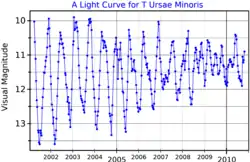T Ursae Minoris
T Ursae Minoris (T UMi) is a variable star in the constellation Ursa Minor, located 2′30″ west-southwest of 3 Ursae Minoris toward the western border of the constellation with Draco.[8]
| Observation data Epoch J2000.0 Equinox J2000.0 | |
|---|---|
| Constellation | Ursa Minor |
| Right ascension | 13h 34m 41.072s[2] |
| Declination | +73° 25′ 53.08″[2] |
| Apparent magnitude (V) | 7.8 - 15[3] |
| Characteristics | |
| Spectral type | M4e-M6e[3] |
| Variable type | SR (previously Mira)[1] |
| Astrometry | |
| Radial velocity (Rv) | −9[4] km/s |
| Proper motion (μ) | RA: −12.919[2] mas/yr Dec.: +5.826[2] mas/yr |
| Parallax (π) | 0.7843 ± 0.0502 mas[2] |
| Distance | 4,200 ± 300 ly (1,280 ± 80 pc) |
| Details | |
| Before onset of period change | |
| Mass | 1.66±0.10[5] M☉ |
| Radius | 290±15[5] R☉ |
| Luminosity | 4,080[6] L☉ |
| Temperature | 3,200±30[5] K |
| Metallicity [Fe/H] | −0.07[5] dex |
| Age | 0.17±0.21[5] Gyr |
| Other designations | |
| Database references | |
| SIMBAD | data |
Properties
A red giant ranging between spectral types M4e and M6e and with a surface temperature of 3,300 K,[1] T Ursae Minoris is a long period semiregular variable star ranging from magnitude 7.8 to 15.[3] These are highly evolved ageing stars that are on the asymptotic giant branch, their wide range in magnitude making them ideal targets for monitoring by amateur star observers.
T Ursae Minoris has been monitored closely since 1905. Up until 1979, its brightness had varied over a period of 310 to 315 days and it was classified as a Mira variable. However, from 1979 its period decreased suddenly to 274 days, and appeared to be decreasing by 2.75 days a cycle since. Variable star observers Janet Mattei and Grant Foster proposed that the star had just undergone a shell helium flash – a point at which "the helium shell around the dense core of the star reaches a critical mass and ignites", which "influences the star's pulsation via changes in surface luminosity and radius".[9] By mid 2008, its period had decreased to 230 days, before changing to pulsation as a semiregular variable star, with a dominant period of 113.6 days. This has been the most dramatic change of any Mira variable. The lack of technetium in its spectrum indicates it is not as advanced in age as some other Mira-type stars, as it has either not yet dredged up this sort of material from its core or is of insufficient mass for this to occur.[1]
A model of T Ursae Minoris shows that following a thermal pulse, its properties are expected to change over a period of only a few years. The period would reduce gradually for about 35 years and then decrease dramatically from about 300 days to about 100 days as the pulsations switch from the fundamental mode to the first overtone. At the same time, the radius and luminosity would decrease from around 4,000 L☉ and 222 R☉ respectively to about 1,500 L☉ and 109 R☉. The radius and luminosity would then increase slowly over the next few thousand years to become larger than before the thermal pulse. Multiple thermal pulses are expected to occur in stars at this stage of their lives, about 100,000 years apart, with the star become gradually larger and cooler until it eventually sheds its outer layers to become a white dwarf.[6] T Ursae Minoris is expected to reach its smallest size in about 50 years time, then begin to slowly increase in size and luminosity again.[5]
References
- Uttenthaler, S.; van Stiphout, K.; Voet, K.; van Winckel, H.; et al. (2011). "The evolutionary state of Miras with changing pulsation periods". Astronomy & Astrophysics. 531: A88. arXiv:1105.2198. Bibcode:2011A&A...531A..88U. doi:10.1051/0004-6361/201116463. S2CID 56226953.
- Brown, A. G. A.; et al. (Gaia collaboration) (August 2018). "Gaia Data Release 2: Summary of the contents and survey properties". Astronomy & Astrophysics. 616. A1. arXiv:1804.09365. Bibcode:2018A&A...616A...1G. doi:10.1051/0004-6361/201833051. Gaia DR2 record for this source at VizieR.
- Watson, Christopher (4 January 2010). "T Ursae Minoris". AAVSO Website. American Association of Variable Star Observers. Retrieved 18 May 2014.
- Feast, Michael W.; Whitelock, Patricia A. (2000). "Mira kinematics from Hipparcos data: A Galactic bar to beyond the Solar circle". Monthly Notices of the Royal Astronomical Society. 317 (2): 460. arXiv:astro-ph/0004107. Bibcode:2000MNRAS.317..460F. doi:10.1046/j.1365-8711.2000.03629.x. S2CID 123295862.
- Molnár, László; Joyce, Meridith; Kiss, László L. (2019). "Stellar Evolution in Real Time: Models Consistent with the Direct Observation of a Thermal Pulse in T Ursae Minoris". The Astrophysical Journal. 879 (1): 62. arXiv:1905.00597. Bibcode:2019ApJ...879...62M. doi:10.3847/1538-4357/ab22a5. S2CID 143424083.
- Fadeyev, Yu. A. (2018). "A Model of the Mira–Type Star T UMi". Astronomy Letters. 44 (8–9): 546–553. arXiv:1803.11387. Bibcode:2018AstL...44..546F. doi:10.1134/S1063773718070010. S2CID 119283616.
- "V* T UMi". SIMBAD. Centre de données astronomiques de Strasbourg. Retrieved 18 May 2014.
- Simpson, Phil (2012). Guidebook to the Constellations: Telescopic Sights, Tales, and Myths. Springer. pp. 22–23. ISBN 978-1-4419-6941-5.
- Mattei, Janet A.; Foster, Grant (1995). "Dramatic Period Decrease in T Ursae Minoris". The Journal of the American Association of Variable Star Observers. 23 (2): 106–16. Bibcode:1995JAVSO..23..106M.
